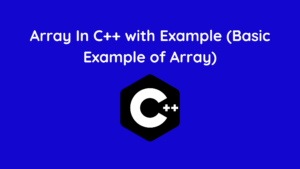In this tutorial, we will learn about introduction to C++ language.
C++ runs on a variety of platforms, including Windows, Mac OS, and various UNIX versions. Stroustrup began working at Bell Labs in 1979.
This C++ tutorial takes a straightforward and practical approach to explain C++ concepts for beginners to advanced users.
Contents
Why to Learn C++?
- C++ is very close to the hardware, allowing us to work at a low level, giving us control over memory management as well as on-hardware better performance, and assisting us in becoming the best software developer.
- C++ programming teaches us the fundamentals of Object-Oriented Programming.
- When we implement virtuals table and pointer, or dynamic type identification, we will understand low-level polymorphism implementation.
- C++ is a popular programming language used by millions of software developers.
- If you are a great C++ programmer, you will never be idle and, more importantly, you will be well compensated for your efforts.
- C++ is one of the most popular programming languages for application and system development.
- C++ teaches you the differences between a compiler, a linker, and a loader, as well as different data types, storage classes, variable types, variable scopes, and so on.
Applications of C++ Programming
- Application Software Development
- Computation Programming
- Games Development
- Embedded System
- This list goes on, there are various areas where software developers are happily using C++ to provide great softwares.
What is Object-Oriented Programming in C++
- Encapsulation
Encapsulation, in general, is the process of enclosing similar code in a single location. In C++, we can group together data members and functions that perform the same function within a single class.
- Data hiding
Data hiding is a method of hiding internal object details, such as data members. It is a method of object-oriented programming. Data hiding ensures, or guarantees, that data access is restricted to class members. It ensures data integrity.
Data hiding is the practice of concealing internal data within a class in order to prevent direct access from outside the class.
- Inheritance
One of the best features of OOPS is inheritance in C++. Inheritance is the process by which existing class features can be used with a new class. It improves the concept of code re-use by allowing code to be reused after it has been written and other features to be added.
- Polymorphism
In C++, polymorphism means that the same entity (function or object) behaves differently in different situations. Consider the following example: When the “+” operator is used in numbers, it performs addition. When the “+” operator is used in strings, it performs subtraction.
introduction to c++introduction to c++introduction to c++introduction to c++introduction to c++introduction to c++introduction to c++introduction to c++ introduction to c++introduction to c++introduction to c++
Difference between C and C++
- Dennis Ritchie created C at AT&T Bell Labs around 1969. Bjarne Stroustrup created C++ in 1979.
- C is a procedural programming language. C++ is a procedural as well as an object-oriented programming language.
- Because C does not support the OOPs concept, it does not support polymorphism; however, because C++ is an object-oriented programming language, it does support polymorphism, encapsulation, and inheritance.
- Because C does not support encapsulation, data behaves as if it were a free entity. C++ encapsulation hides data to ensure that data structures and operators are used as intended and can be manipulated by outside code.
- C is a function-driven language, whereas C++ is an object-driven language.
We hope that this article will assist you in understanding all about introduction to c++. We have concentrated on making a basic, meaningful, and easy-to-learn guide to the concepts. Still, if you have any problems regarding this, please post them in the comment section, we will be glad to assist you.
You might like:
Introduction to Java | Java Tutorial | Java language




Pingback: Features of C++ | C++ Tutorial - Developers Dome
Pingback: C++ Basic Syntax | C++ Tutorial - Developers Dome
Pingback: Data Types in C++ - Developers Dome
Pingback: Input and Output in C++ | C++ Programming - Developers Dome